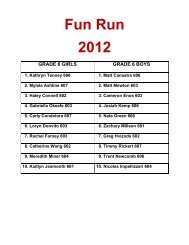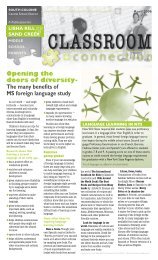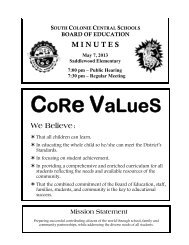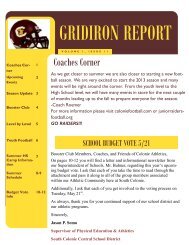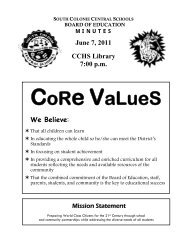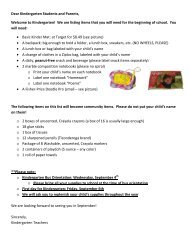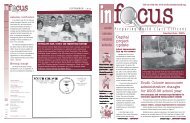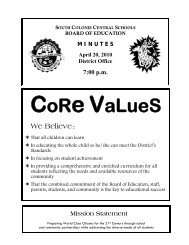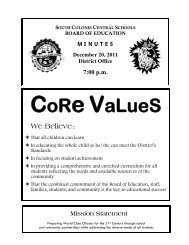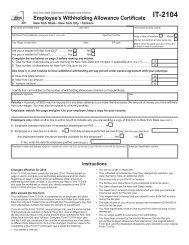Peaceful School Bus Program - South Colonie Central Schools
Peaceful School Bus Program - South Colonie Central Schools
Peaceful School Bus Program - South Colonie Central Schools
Create successful ePaper yourself
Turn your PDF publications into a flip-book with our unique Google optimized e-Paper software.
<strong>Peaceful</strong><br />
<strong>School</strong> <strong>Bus</strong><br />
<strong>Program</strong><br />
<strong>School</strong> <strong>Bus</strong><br />
<strong>School</strong> <strong>Peaceful</strong> <strong>Bus</strong><br />
<strong>Program</strong><br />
© 2008 by Hazelden Foundation. All rights reserved.
What are some common<br />
problems on school buses?<br />
• Bullying<br />
• Older students “staking claim” to<br />
certain areas of the school bus<br />
• Loud noise, shouting<br />
• Disrespect of personal property<br />
• Other problems
Why is the environment on a<br />
school bus so difficult to manage?<br />
• It is an impersonal environment: students<br />
all sit facing forward.<br />
• The driver is not looking directly at the<br />
students.<br />
• The driver is often farthest away from<br />
the students who are causing<br />
problems.
Difficult environment<br />
(continued)<br />
• The noise level is very loud.<br />
• The bus has no visible connection to<br />
school or home.<br />
• The bus is often a cramped space.<br />
• Usually only overt physical actions are<br />
caught; more subtle problems are missed.<br />
• Problems that go undetected can<br />
escalate.
Why don’t traditional disciplinary<br />
approaches alone work?<br />
• They only address a fraction of the<br />
harmful behaviors that occur.<br />
• They don’t address hurtful behaviors<br />
that are not against the rules.<br />
• They fail to teach students the skills<br />
or knowledge needed to solve<br />
conflicts effectively.
The problems with traditional<br />
approaches (continued)<br />
• They make the students who get caught<br />
more self-centered and less empathetic.<br />
• They require students to think rationally in<br />
a very emotional environment.<br />
• They set low expectations for student<br />
behavior.
A different approach<br />
is needed . . .<br />
The <strong>Peaceful</strong> <strong>School</strong> <strong>Bus</strong> <strong>Program</strong>!
What is the <strong>Peaceful</strong> <strong>School</strong><br />
<strong>Bus</strong> <strong>Program</strong>?<br />
• A schoolwide program<br />
• A program designed to decrease<br />
inappropriate behavior on the school bus<br />
• A program designed to create a climate<br />
of respect and cooperation on the bus<br />
• A program designed to change the<br />
social dynamics on the bus by building<br />
strong relationships among students<br />
and the bus driver
The <strong>Peaceful</strong> <strong>School</strong> <strong>Bus</strong><br />
<strong>Program</strong> is not a . . .<br />
• Discipline program<br />
• Training for bus drivers<br />
• Curriculum
Who is the <strong>Peaceful</strong> <strong>School</strong><br />
<strong>Bus</strong> <strong>Program</strong> designed for?<br />
• The program is designed for students in<br />
elementary school and can be adapted for<br />
middle school or junior high school students.<br />
• The program can be used with high school<br />
students if they play a mentoring role.<br />
• The program can be adapted for use with<br />
after-school programs, sports teams,<br />
and other youth-serving organizations.
What are the goals<br />
of the program?<br />
The main goal:<br />
Develop a positive and<br />
safe environment on the<br />
school bus for all students.
The main goal is achieved by<br />
addressing these subgoals<br />
• Decrease the amount of inappropriate<br />
behaviors on the school bus.<br />
• Decrease the amount of time spent<br />
disciplining students for inappropriate<br />
behaviors on the school bus.<br />
• Decrease the amount of bullying<br />
that occurs on the school bus.
Subgoals (continued)<br />
• Increase students’ sense of responsibility<br />
for what happens on the school bus.<br />
• Create a cooperative and supportive<br />
relationship between the school and<br />
the school transportation department.<br />
• Recognize the identity of the bus<br />
route group as an important entity.
Subgoals (continued)<br />
• Create greater trust among all stakeholders<br />
in the school bus: students, parents, school staff<br />
members, and transportation staff members.<br />
• Improve communication among all stakeholders.<br />
• Support and strengthen the existing discipline<br />
procedures designed to address school<br />
bus problems.
What is the history<br />
of the program?<br />
• It was developed in a real-world setting in<br />
an elementary school in upstate New York.<br />
• Prior to implementation, the school had<br />
approximately 58 bus discipline referrals<br />
per year.<br />
• The average number of bus<br />
discipline referrals per year after<br />
implementation was 9.
History of the program<br />
(continued)<br />
• In 2004, the New York State Sharing<br />
Success Network recognized the program<br />
as a Promising Practice.<br />
• The program has now been successfully<br />
implemented in other school districts.<br />
• It is being well-received at state and<br />
national education and school<br />
transportation conferences.
What are the program’s<br />
key principles?<br />
• Principle 1: Accept problems as<br />
opportunities for learning.<br />
• Principle 2: Change the social<br />
environment of the school bus and<br />
students’ behavior will change.
Key principles (continued)<br />
• Principle 3: Influence can be powerful<br />
in changing behavior.<br />
• Principle 4: Changing the social<br />
environment and improving each<br />
student’s experience on the bus<br />
is a shared responsibility.
Key principles (continued)<br />
• Principle 5: The gesture itself<br />
(implementing the program) has power<br />
and influence.<br />
• Principle 6: Problems will still occur but<br />
they will be easier to resolve if they’re<br />
identified when they are small<br />
rather than when they are big.
Key principles (continued)<br />
•Principle 7: Students must develop a<br />
sense of responsibility or the sense that<br />
they can effect change in a variety of<br />
positive ways.<br />
•Principle 8: Significant change takes<br />
time and commitment.
Key principles (continued)<br />
•Principle 9: Education works.
What are the program’s<br />
main components?<br />
• Establish a schoolwide committee to<br />
coordinate implementation.<br />
• Hold a training for all participating<br />
school staff.<br />
• Inform parents of the program.<br />
• All students in a bus route group<br />
meet approximately 3 times a<br />
year for 45 minutes each time.
A bus route group is . . .<br />
A group of students who<br />
regularly ride to and from school<br />
together on a school bus.
Main components<br />
(continued)<br />
• A team of teachers and teaching<br />
assistants lead the bus route group<br />
meetings.<br />
• <strong>School</strong> transportation staff and bus<br />
drivers are invited to participate in<br />
the program.<br />
• Regular check-ins are done<br />
with bus drivers.
Main components<br />
(continued)<br />
• The program is repeated annually and<br />
becomes part of the regular school schedule.<br />
• During the meetings, students take part in<br />
activities designed to build relationships.<br />
• During the meetings, students in higher<br />
grades are paired with students in lower<br />
grades.
Main components<br />
(continued)<br />
• During the meetings, students discuss bus<br />
problems and solutions.<br />
• During the meetings, students are taught<br />
about bullying.<br />
• Processes are put in place to facilitate<br />
reporting of bullying or other negative<br />
behaviors on the school bus.
Why use the <strong>Peaceful</strong><br />
<strong>School</strong> <strong>Bus</strong> <strong>Program</strong>?<br />
• It approaches school bus problems from a<br />
positive perspective.<br />
• It moves schools from a reactive approach<br />
to a proactive approach.<br />
• It puts character education into practice.<br />
• It demonstrates the school’s commitment to<br />
parents and students.<br />
• It creates a greater sense of teamwork<br />
among school staff members and<br />
bus drivers.
What is required to<br />
implement the program?<br />
• Very little financial cost—all materials are<br />
provided in the implementation guide.<br />
• The implementation guide includes a manual,<br />
a CD-ROM, and a DVD.<br />
• One guide is needed for each committee<br />
member and each bus route group leader.<br />
• One guide is needed for each school<br />
administrator.<br />
• No specialized training is required.
What is required to implement<br />
the program? (continued)<br />
• The program does require administrative<br />
support and staff buy-in.<br />
• The program will require some changes<br />
to the school calendar.<br />
• The program needs to be implemented<br />
over the long-term.
What is the role of a bus<br />
route group leader?<br />
•Meet and greet students as they arrive<br />
at the bus route group meeting location<br />
•Lead the meeting activities<br />
•Help adapt or revise activities to fit the<br />
needs of students
What happens at a bus route<br />
group meeting?<br />
• Student arrival<br />
• At the start<br />
• Getting attention<br />
• Checking for understanding<br />
• Forming pairs<br />
• Energizers and warm-ups<br />
• Main activity<br />
• Large group processing<br />
• Dismissal
What is covered in the<br />
meeting’s main activity?<br />
• Orientation to the <strong>Peaceful</strong> <strong>School</strong> <strong>Bus</strong><br />
<strong>Program</strong><br />
• Building identity for the bus route group<br />
• Problem-solving<br />
• Bullying issues<br />
• Assessment and affirmation
A time for questions and<br />
answers . . .<br />
(Insert your contact information here)<br />
Every Child Deserves a<br />
<strong>Peaceful</strong> <strong>School</strong> <strong>Bus</strong>!<br />
© 2008 by Hazelden Foundation. All rights reserved.



